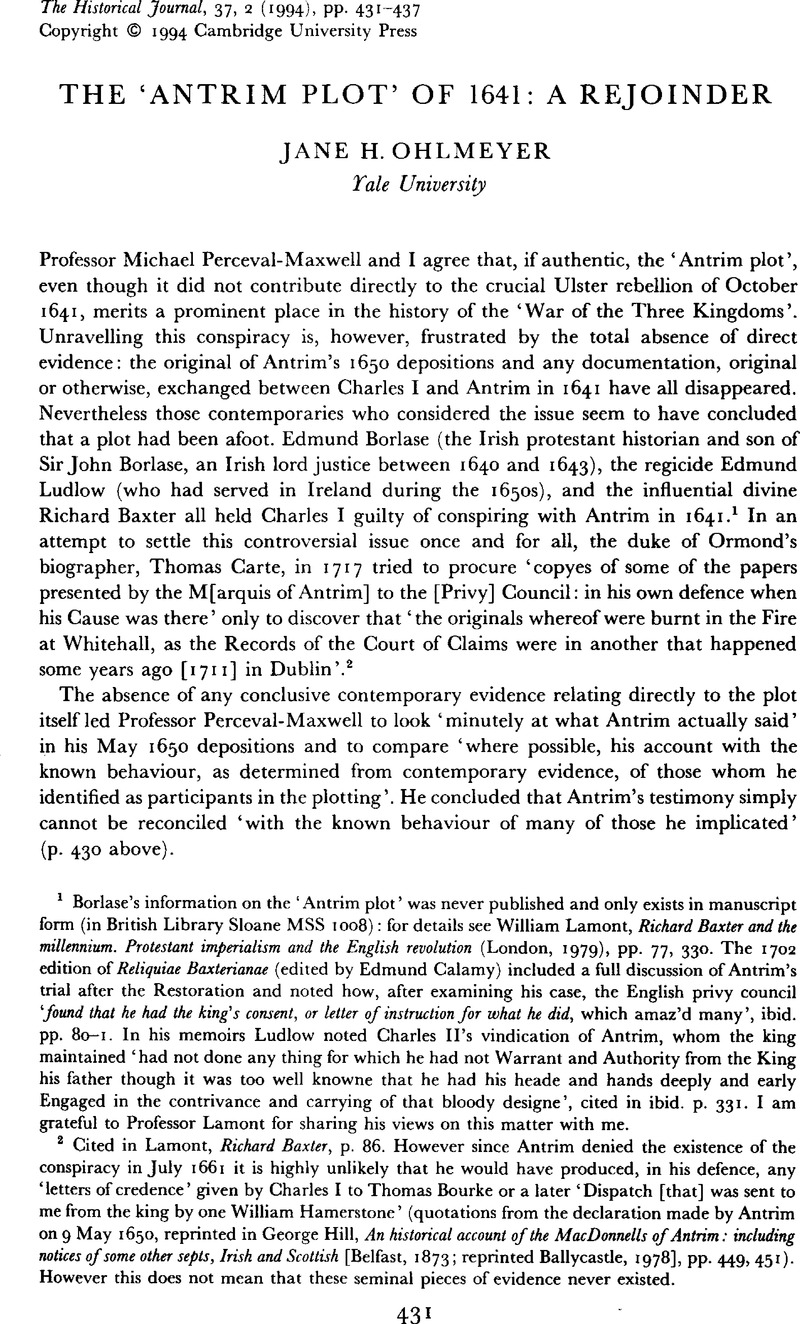No CrossRef data available.
Article contents
The ‘Antrim Plot’ of 1641: a rejoinder
Published online by Cambridge University Press: 11 February 2009
Abstract

- Type
- Debate
- Information
- Copyright
- Copyright © Cambridge University Press 1994
References
1 Borlase's information on the ‘Antrim plot’ was never published and only exists in manuscript form (in British Library Sloane MSS 1008): for details see William, Lamont, Richard Baxter and the millennium. Protestant imperialism and the English revolution (London, 1979), pp. 77, 330Google Scholar. The 1702 edition of Reliquiae Baxterianae (edited by Edmund Calamy) included a full discussion of Antrim's trial after the Restoration and noted how, after examining his case, the English privy council ‘found that he had the king's consent, or letter of instruction for what he did, which amaz'd many’, ibid, pp. 80–1. In his memoirs Ludlow noted Charles II's vindication of Antrim, whom the king maintained ‘had not done any thing for which he had not Warrant and Authority from the King his father though it was too well knowne that he had his heade and hands deeply and early Engaged in the contrivance and carrying of that bloody designe’, cited in ibid. p. 331. I am grateful to Professor Lamont for sharing his views on this matter with me.
2 Cited in Lamont, , Richard Baxter, p. 86Google Scholar. However since Antrim denied the existence of the conspiracy in July 1661 it is highly unlikely that he would have produced, in his defence, any ‘letters of credence’ given by Charles I to Thomas Bourke or a later ‘Dispatch [that] was sent to me from the king by one William Hamerstone’ (quotations from the declaration made by Antrim on 9 May 1650, reprinted in George, Hill, An historical account of the MacDonnells of Antrim: including notices of some other septs, Irish and Scottish [Belfast, 1873; reprinted Ballycastle, 1978], pp. 449, 451)Google Scholar. However this does not mean that these seminal pieces of evidence never existed.
3 Hill, , An historical account of the MacDonnells of Antrim, p. 449Google Scholar. The italics are mine. The phrase ‘should be armed out of the store in Dublin' surely refers to the extra 12,000 men to be raised and not to the 8,000 already in arms. The fact that there were probably insufficient arms available for these recruits would not have deterred the impractical Charles I who, the previous year, during the First Bishops’ War, had given little consideration to the logistics of arming, feeding, transporting and financing the troops he ordered Antrim to raise. For further details see Ohlmeyer, Jane H., Civil war and restoration in the three Stuart kingdoms: the career of Randal MacDonnell, marquis of Antrim, 1609–1683 (Cambridge, 1993), pp. 83–6, 91Google Scholar. Interestingly inJune 1636 Wentworth had suggested to the king that the Irish standing army – then 2,600 men – could be increased to 20,000 and suggested that these recruits be armed ‘by imprest’. He added that he had in Ireland a reserve (‘a dead stock’) of arms and horse to the value of £4,000, Calendar of state papers relating to Ireland, 1633–47, p. 133.
4 Hill, , An historical account of the MacDonnells of Antrim, p. 450.Google Scholar
5 Perceval-Maxwell convincingly demonstrates that Bourke could not have delivered his message early in June; but this ignores the fact that he could have travelled to Ireland to deliver the message late in April or early in May (see p. 425, note 25 above).
6 See Gardiner's, S. R. entry on Strafford in Dictionary of national biography and History of England from the accession of James I to the outbreak of the civil war, 1603–1642 (10 vols., London, 1863–1981; later edition, New York, 1965), IX, 340–4, 357Google Scholar. Also see Russell, Conrad, The fall of the British monarchies 1637–1642 (Oxford, 1990), pp. 289–98.Google Scholar
7 Gardiner, , History of England, IX, 334–5, 344.Google Scholar
8 Calendar of state papers relating to Ireland, 1633–47, p. 289. Presumably Charles's order of 8 May left Antrim and Ormond in a quandary about how best to proceed and helps to explain their eagerness to send to the king for further instructions. Given the time frame they must have scheduled their County Kildare meeting after 14 May, by which point Ormond had become deeply involved in disbanding the army, in accordance with the king's wishes. Ormond's failure to attend the rendez-vous in person highlights his ambivalence about the venture; while Antrim's reluctance to proceed alone is entirely understandable. No doubt, Antrim vividly recalled how during the First Bishops' War Charles had behaved in a similar fashion. On 11 April 1639 the king had decided to issue a formal commission for Antrim to raise forces for the Scottish war; however, two days later a second communication, dated 13 April, suggested delaying the expedition to the following spring. In the resulting chaos and confusion Antrim was used as a scapegoat and blamed for the failure of the mission, Ohlmeyer, , Civil war and restoration, pp. 87–91.Google Scholar
9 Hill, , An historical account of the MacDonnells of Antrim, p. 450Google Scholar. It does not confirm, as Perceval-Maxwell argues, that the meeting with Colonel John Barry, Ormond's messenger and one of the colonels nominated to raise troops, ‘who could have told him everything he needed to know, had not yet taken place’ (p. 427 above).
10 For further details see Ohlmeyer, , Civil war and restoration, pp. 260, 269–71.Google Scholar
11 It appears that Hill made a number of minor errors as he transcribed Cox. For instance in Hill's version we find ‘beteen Killaghan’; while the original reads ‘between Killehan’. However apart from a few differences in spelling and the omission of a phrase (note 12 below) Hill's account is a verbatim copy of Cox.
12 Hill omitted the phrase ‘belonging to the late Countess-Dowager of Kildare’.


